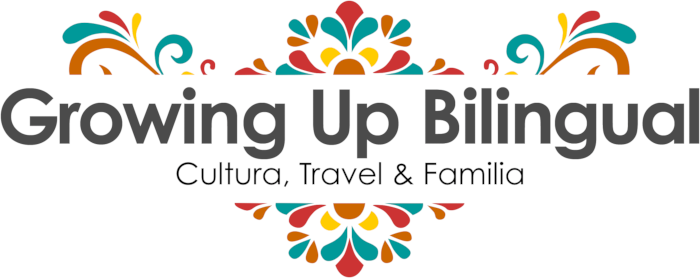The importance of marigolds in Day of the Dead (Dia de los Muertos) celebrations is multifaceted and deeply rooted in tradition. Due to their symbolic significance, marigolds are an essential part of the Día De Los Muertos celebrations. These bright orange and yellow flowers are chosen for several reasons, from their symbolism to their bright colors and the way they are used to decorate ofrendas, making them an essential part of this cherished Mexican holiday.

In addition to their symbolism, marigolds are chosen for Day of the Dead celebrations because they are in full bloom during the fall months when this holiday takes place. Their brilliant presence adds to the festive atmosphere and reminds people that life is celebrated even in death.
I will share not only why Marigolds or cempasúchil flowers are essential in the Day of the Dead in Mexico but also how these flowers are used in different ways during the Dia de los Muertos celebrations.
Historical and Cultural Significance of Marigolds in Mexico
Marigolds’ historical and cultural significance in Mexico is closely tied to indigenous beliefs and traditions. Marigolds, or cempasúchil in Nahuatl, have deep-rooted connections to indigenous beliefs and traditions in Mexico. Cempasúchilwith their brilliant orange and yellow hues, were revered by the Aztecs as symbols of the sun and warmth of life.
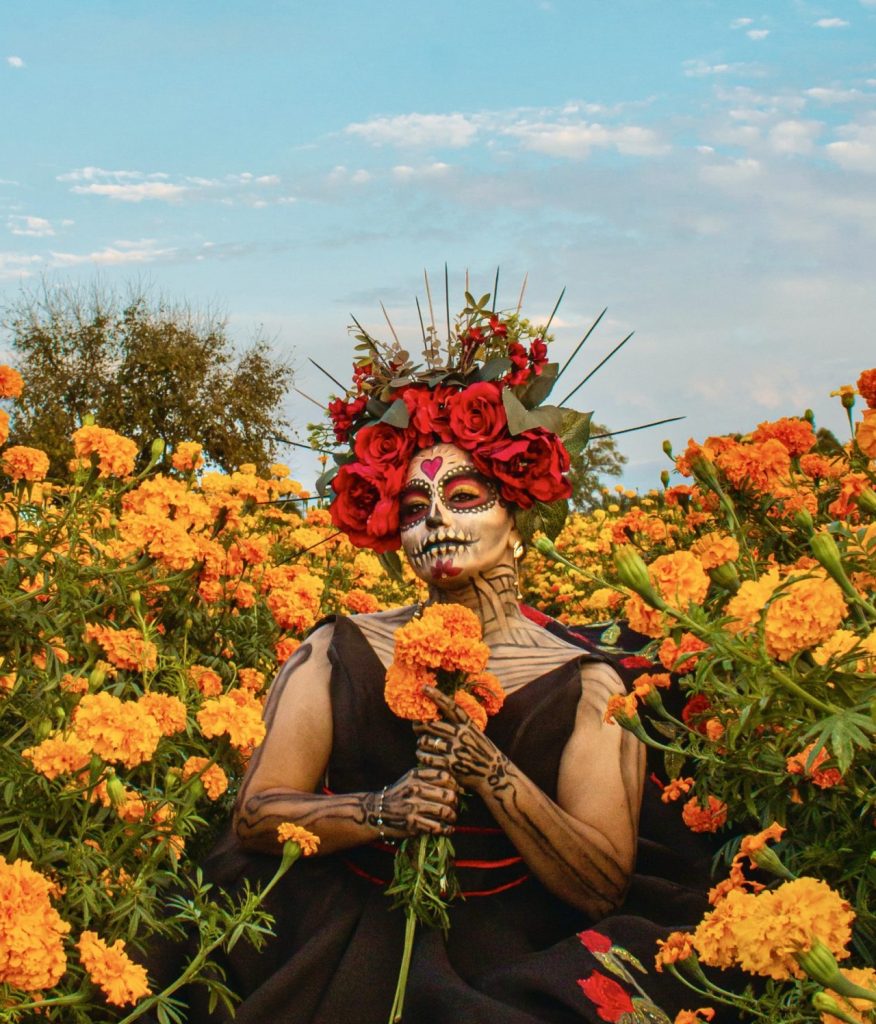
According to Aztec mythology, the sun god Huitzilopochtli required constant sustenance to continue his journey across the sky. Mexican people believe the cempasúchil’s radiant colors were thought to guide the souls of the deceased back to the world of the living during Dia de los Muertos. Marigolds were extensively used in religious ceremonies, and their petals were strewn along pathways to create a fragrant and colorful welcome for returning spirits.
Today, marigolds remain a central element of Dia de los Muertos altars and ofrendas, continuing to represent the enduring connection between life, death, and the vibrant memory of loved ones.
The Aztec Legend of the Cémpasuchil Flower
In the heartwarming legend of the Day of the Dead Cempasuchil flower, two young Aztec lovers, Xóchitl and Huitzilin, share a deep bond that ultimately gives rise to the cempasuchil flower, known as the Day of the Dead flower. Their enduring love story begins in childhood as they explore their Aztec town together. They make offerings to the Sun god Tonatiuh on a mountain peak, where they pledge eternal love to each other.
Tragically, Huitzilin is sent off to war and is presumed dead, leaving Xóchitl heartbroken. She climbs the mountain one last time to plead with the Sun god, and her wish is granted as she transforms into a cempasuchil flower, while Huitzilin is reborn as a hummingbird. The flower’s twenty petals open, emitting a captivating scent and so the cempasuchil and the hummingbird come together. Their love story continues, with the cempasuchil flower symbolizing their eternal bond.
What do Marigolds Symbolize in Día de los Muertos Celebrations?
Marigolds, known as “cempasúchil” in Spanish, hold profound symbolic significance in the vibrant tapestry of Día de los Muertos, the Mexican Day of the Dead celebration. These radiant blooms, often referred to as “the flower of the dead,” play a multifaceted role in honoring and connecting with departed loved ones. Whether they are used to decorate ofrendas and graves at the cemetery or as part of traditional Day of the Dead costumes they are one of the most recognizable symbols of el Dia de los Muertos.
Here’s a breakdown of what marigolds symbolize in these cherished celebrations:
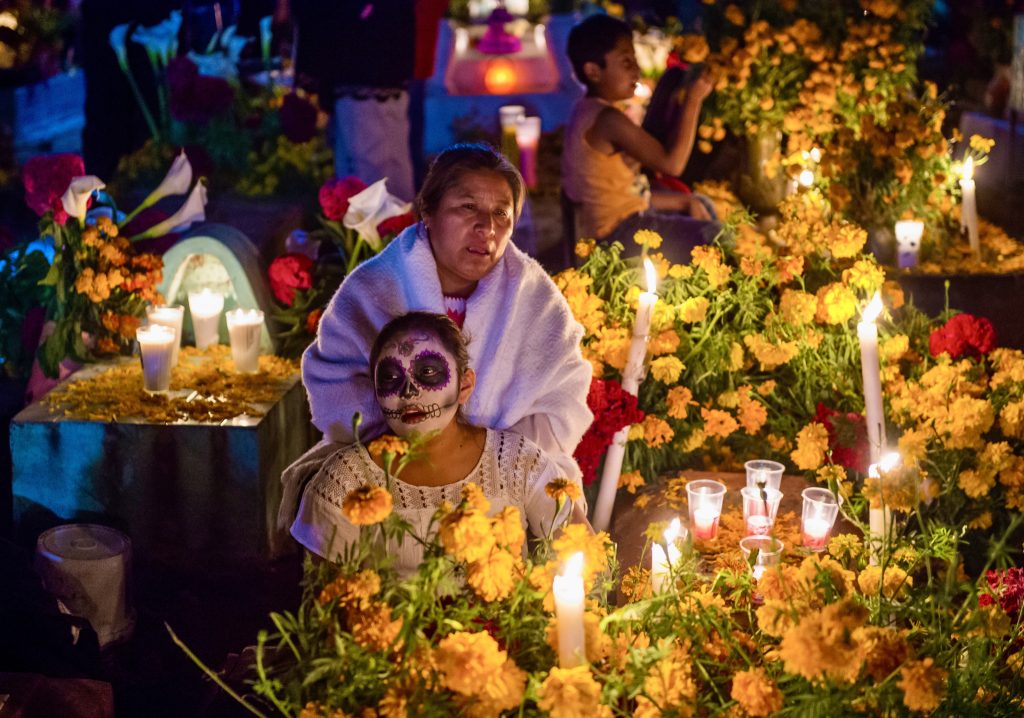
- Symbols of the Sun and Warmth of Life: Marigolds’ intense orange and yellow hues symbolize the sun and its life-giving warmth. In Mexican culture, the sun is considered the ultimate source of life, and it’s believed to provide energy to the spirits returning for the Day of the Dead celebration.
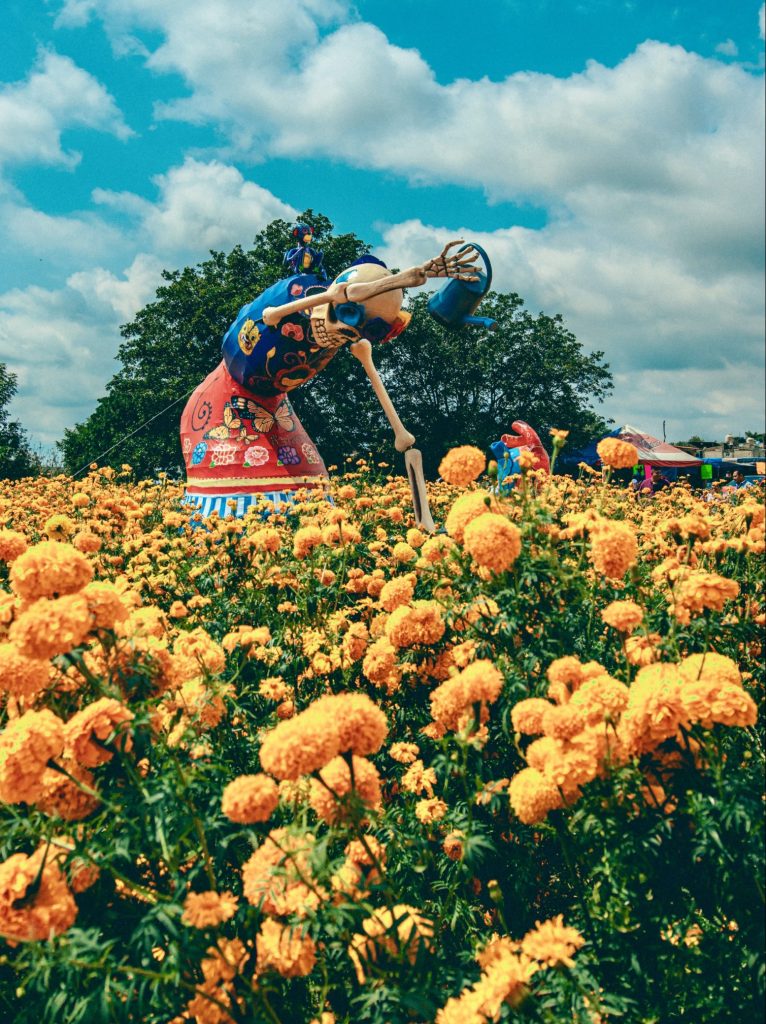
- Guiding the Spirits: Marigolds are thought to act as pathways for the souls of the departed. Their bright colors light the way, helping spirits find their ofrendas (altars) and the offerings left by their loved ones.
- Attracting and Honoring Spirits: These vibrant flowers are believed to attract and honor the souls of loved ones who have passed away. Marigolds ensure that the spirits are present and welcomed during the celebration.
- The fragrance of Comfort: The sweet, earthy scent of marigolds is thought to offer comfort to the visiting spirits. This fragrance provides solace and helps the spirits feel at ease as they return to visit their families.
- Enduring Connection: Marigolds represent the enduring connection between life, death, and the cherished memory of loved ones. They serve as a powerful reminder of the importance of honoring and celebrating the lives of those who have passed away.
- Hope and Remembrance: Amidst the darkness of the season, marigolds’ radiant presence symbolizes hope and remembrance. They bridge the realms of the living and the dead, evoking unity and a sense of remembrance among those participating in the celebration.
How are Marigolds Used To Decorate Day of the Dead Ofrendas or Altars
Marigolds, or cempasúchil flowers, are used to decorate ofrendas in many different ways. These vibrant flowers are chosen for their symbolism and aesthetic qualities, contributing to creating meaningful and visually captivating ofrendas and to decorate the graves at the cemetery.
In addition to marigolds, other essential elements are thoughtfully incorporated into the altar decorations. These elements include photographs of loved ones who have passed away. Pan de muerto, a sweet bread or pan dulce, is traditionally placed on the ofrendas. Candles or lanterns are added to guide the spirits. Sugar skulls are also a typical decoration in ofrendas, often personalized with the names of the deceased. Traditional Day of the Dead foods like ayotes en miel, a sweet squash dessert, are also part of the altars along with favorite foods and mementos of our loved ones who have passed away to create a truly personalized and meaningful ofrenda.
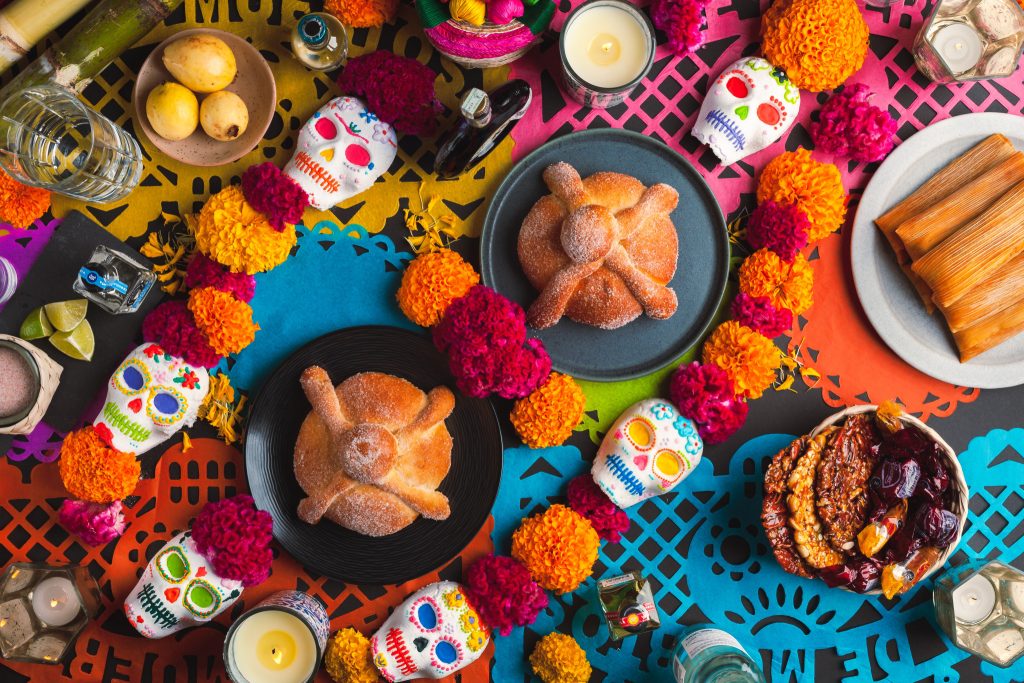
Here are some of how marigolds are used for decorating Day of the Dead ofrendas or altars:
- Marigold Garlands and Arches: Marigolds, also known as “cempasúchil”, are meticulously woven into garlands or used to make flower arches . These garlands and arches, adorned with brilliant orange and yellow blossoms, drape the ofrendas and altars. They symbolize the sun’s warmth and life’s eternal cycle as well as the pathways the souls can follow back to the land of the living.
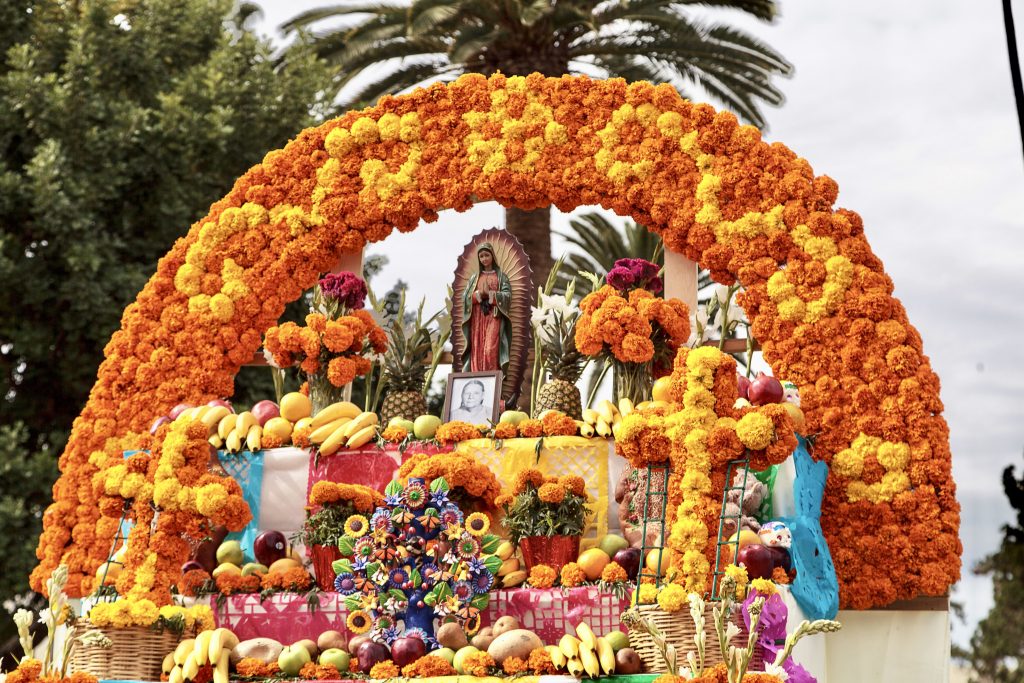
- Altar Borders: Marigold garlands are often used to border the edges of the ofrendas. Their radiant colors create a vivid frame around the altar, drawing attention to the central elements and photographs of the deceased.
- Flower Arrangements: Marigolds are incorporated into elaborate flower arrangements that adorn ofrendas. These arrangements can take various forms, including wreaths and bouquets. Alongside marigolds, other Day of the Dead flowers like cockscomb (celosia) and Mexican marigold (cempasúchil) are used to create visually stunning displays. These flowers symbolize the fleeting nature of life and the beauty of memories.
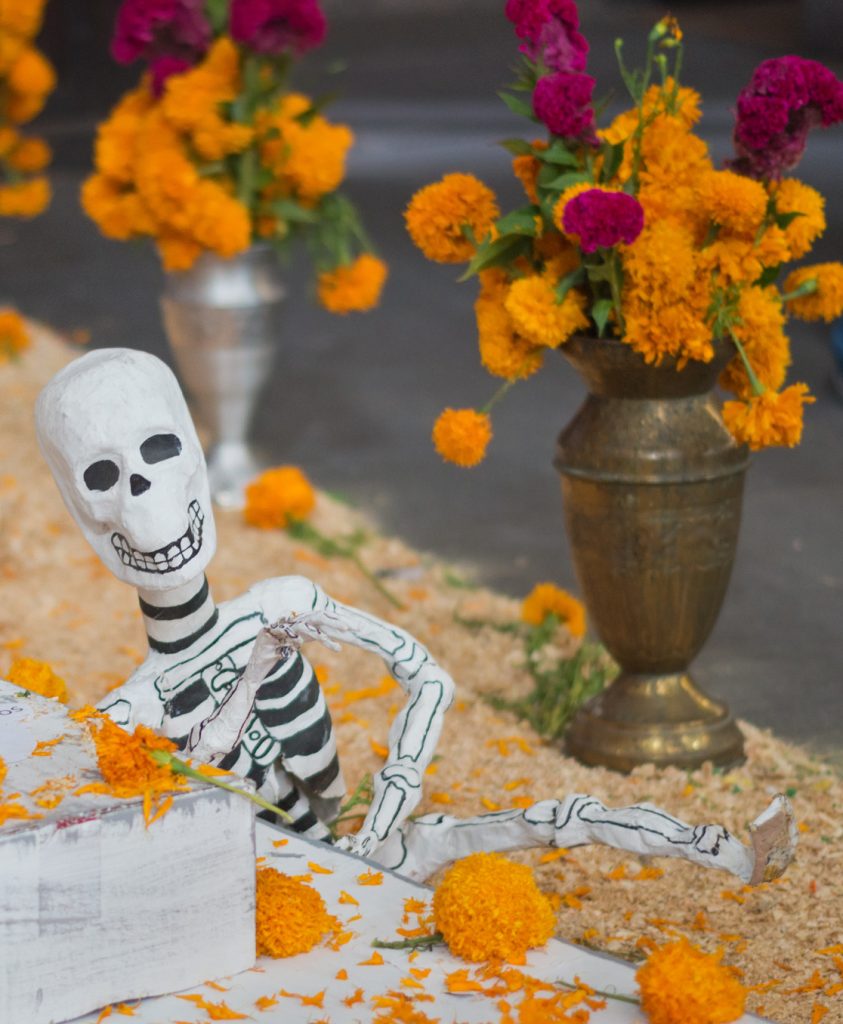
- Petal Scattering and Marigold Pathways: Marigold petals are scattered along the pathways leading up to the ofrendas. This practice creates a fragrant and colorful welcome for the spirits of the deceased as they journey back to the world of the living. The petals symbolically guide and attract the spirits to their designated ofrendas, creating petal pathways that connect the realms of the living and the dead.
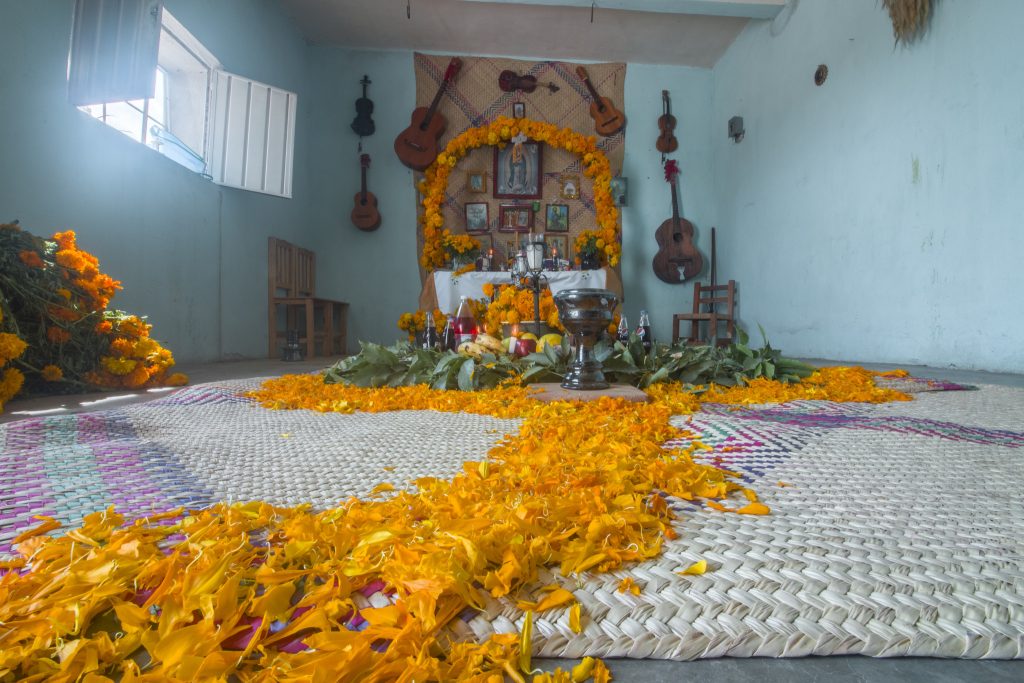
- Centerpiece: Marigold arrangements often serve as the centerpiece of the ofrenda. Placed prominently, they symbolize the enduring connection between life, death, and the vibrant memory of loved ones. Their bright colors capture attention and create a focal point for the altar.
- Marigold Backdrops: Marigolds are often used to make backdrops for the altars or ofrendas, these can be just a combination of flowers but sometimes they are created in the shape of skulls or crosses.
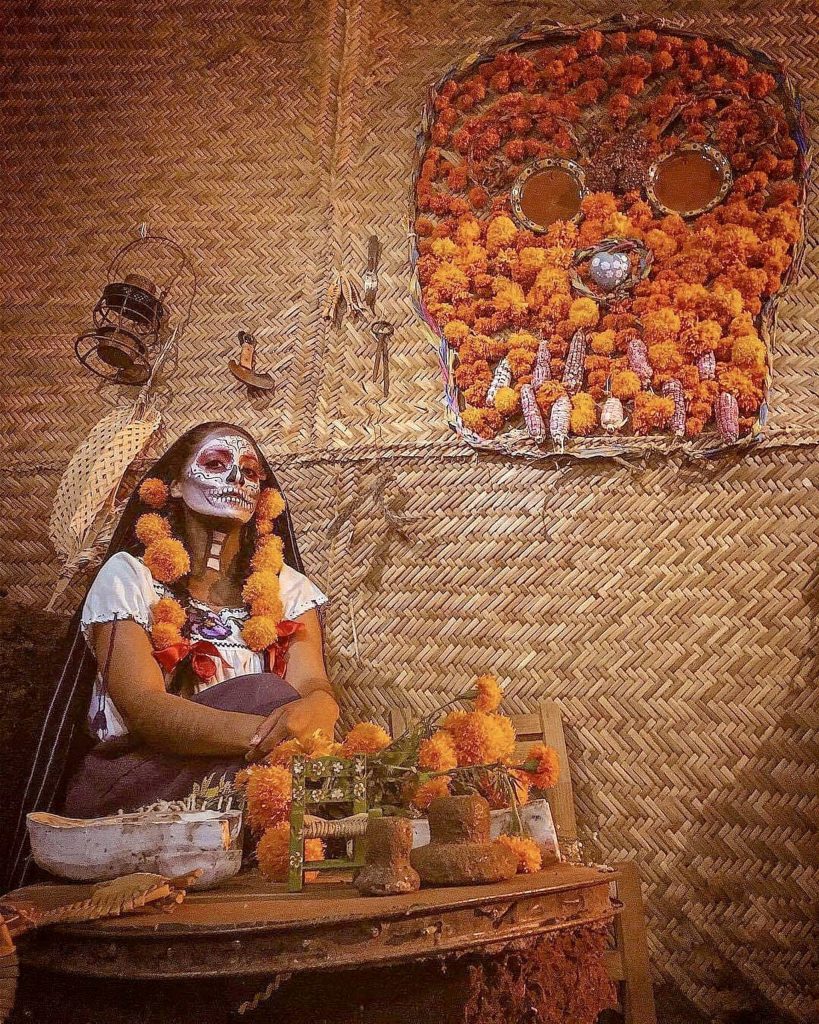
- To Create Day of the Dead tapetes (Flower and Sawdust Rugs): In some regions, marigolds are used to create intricate tapetes or flower and sawdust rugs on the ground around the ofrenda. These decorative patterns and designs often feature marigolds as a prominent element, adding to the overall visual spectacle of the ofrenda.
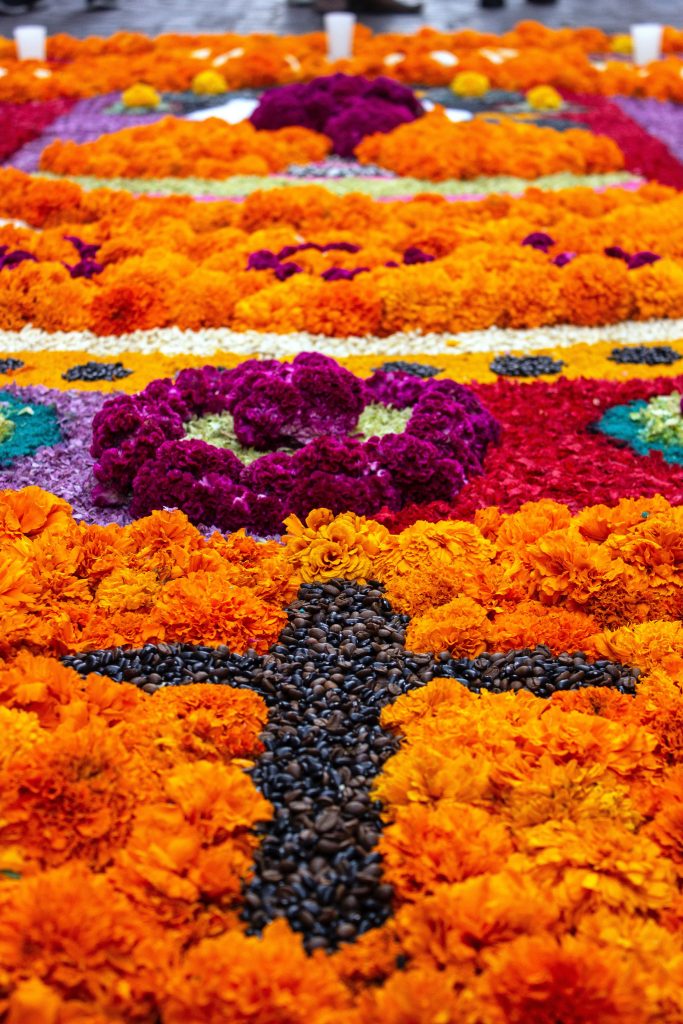
Marigolds help create a sacred and visually stunning space where memories are cherished and the spirits are welcomed with love and respect. By incorporating marigolds, along with other Day of the Dead flowers and elements, into the decoration of ofrendas and altars, families and communities pay tribute to their loved ones who have passed away.
Varieties of Marigolds Most Commonly Used for the Dia de los Muertos or Day of the Dead Celebrations
A few varieties of marigolds are commonly used for the Day of the Dead celebrations. Here is each variety and how they are incorporated into the Dia de los Muertos traditions, from flower arrangements and altar decorations and garlands to flower carpets or tapetes.

- Aztec marigold, Mexican marigold, or cempasúchil (Tagetes erecta): Cempasúchil is the Aztec name for the marigold flower native to Mexico, scientifically known as Tagetes erecta. This tall and robust variety, also known in Mexico as the flor de muerto, is often the star of the show during Day of the Dead celebrations. Its large, bright orange or yellow blooms are striking and highly symbolic, representing the sun’s warmth and the deceased’s journey.
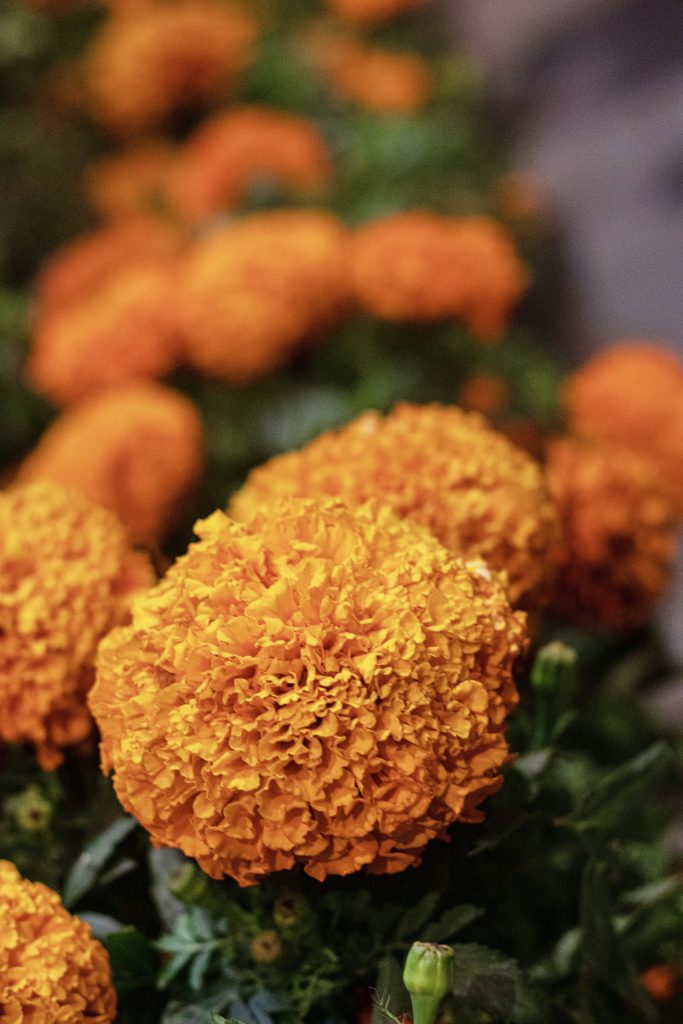
- French marigolds (Tagetes patula): These marigolds, often called French marigolds, are smaller in stature compared to their African counterparts. They come in various vibrant colors, including shades of orange and yellow, which make them a popular choice for creating intricate floral arrangements and garlands.
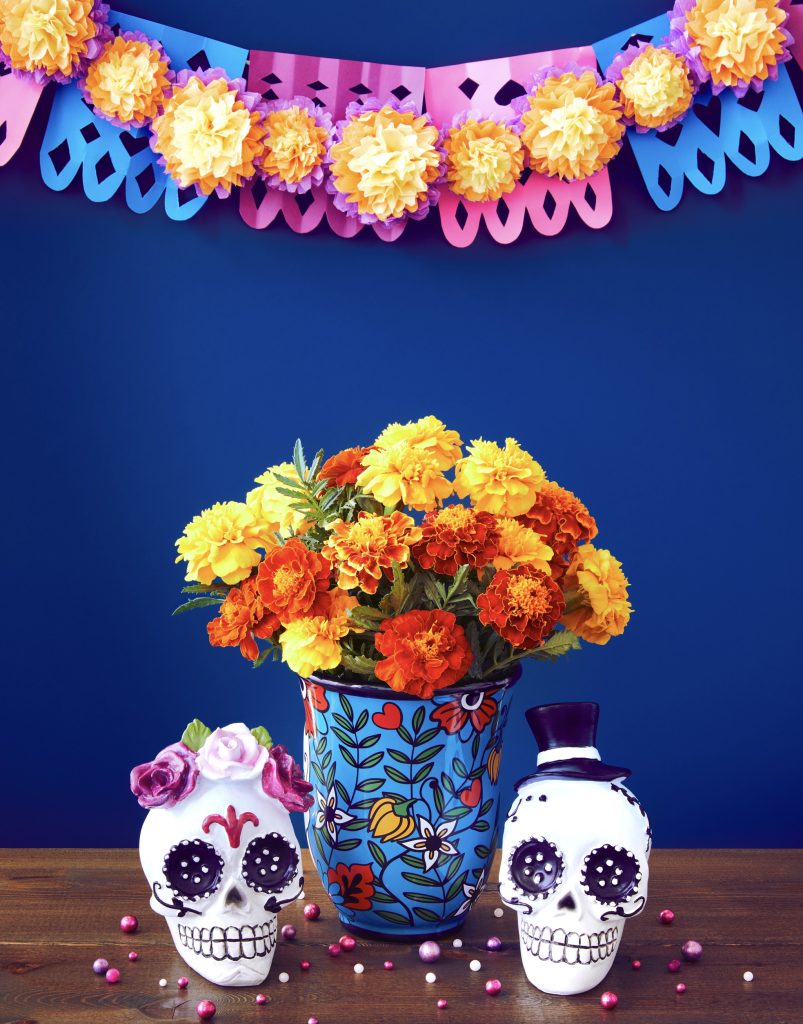
- Signet marigolds (Tagetes tenuifolia): These petite and delicate marigolds add a lovely touch to Day of the Dead decorations. They feature small, single flowers and finely cut foliage, making them ideal for crafting and detailing.

- Mexican tarragon (Tagetes lucida): This variety, often called Mexican tarragon or Texas tarragon, emits a sweet and fragrant scent from its leaves. The Aztecs incorporated Tagetes lucida into a ceremonial incense called Yauhtli. While not as commonly used for decoration as other marigold types, its aromatic foliage adds a sensory dimension to the ofrendas and altars, providing a comforting and inviting atmosphere for the visiting spirits during the Day of the Dead festivities. The belief in the soothing power of marigold fragrance is an integral part of these flowers’ spiritual and cultural significance in this cherished Mexican tradition.
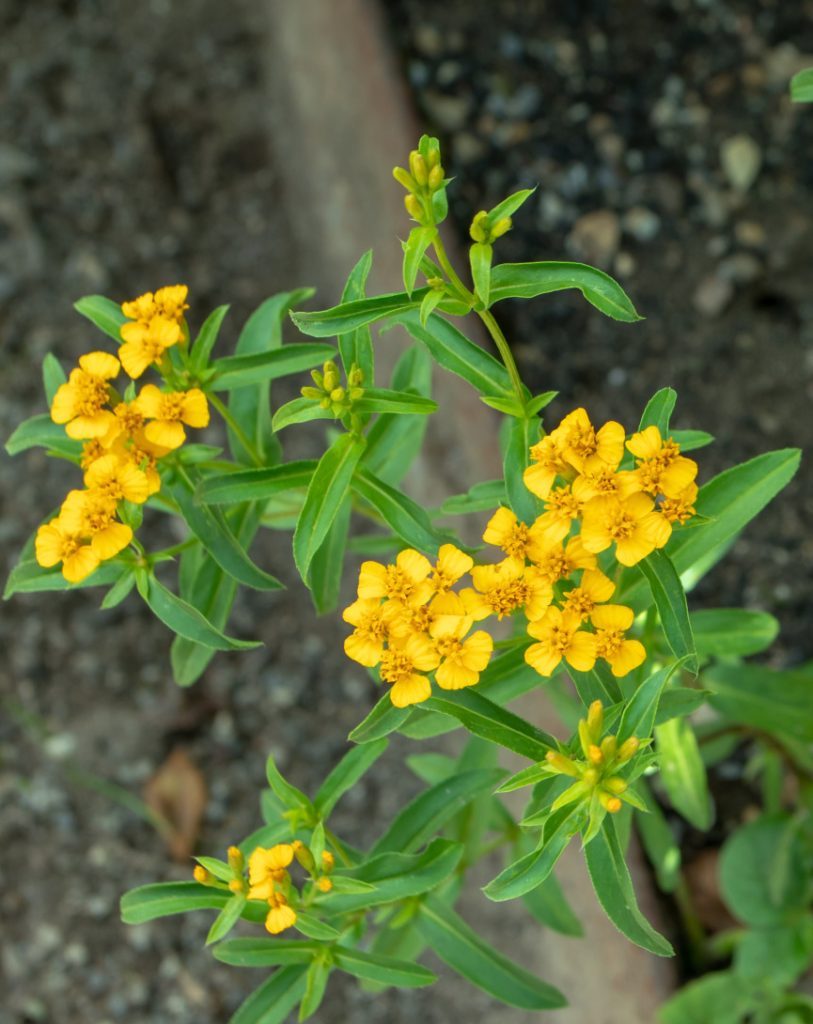
- Hybrid Marigold Varieties: Over time, various color combinations have been developed, providing artists and decorators with even more options to create vibrant and visually stunning Day of the Dead displays.
These diverse marigold varieties contribute to the rich tapestry of colors and symbolism that characterize the Day of the Dead celebrations, making each altar and ofrenda a unique and heartfelt tribute to the departed souls.
Marigolds as inspiration for Día De Los Muertos art and Day of the Dead crafts
Marigolds inspire Día De Los Muertos art and Day of the Dead crafts, infusing these creative activities with vivid colors and meaningful symbols.
Let’s explore the various ways marigolds influence these artistic pursuits:
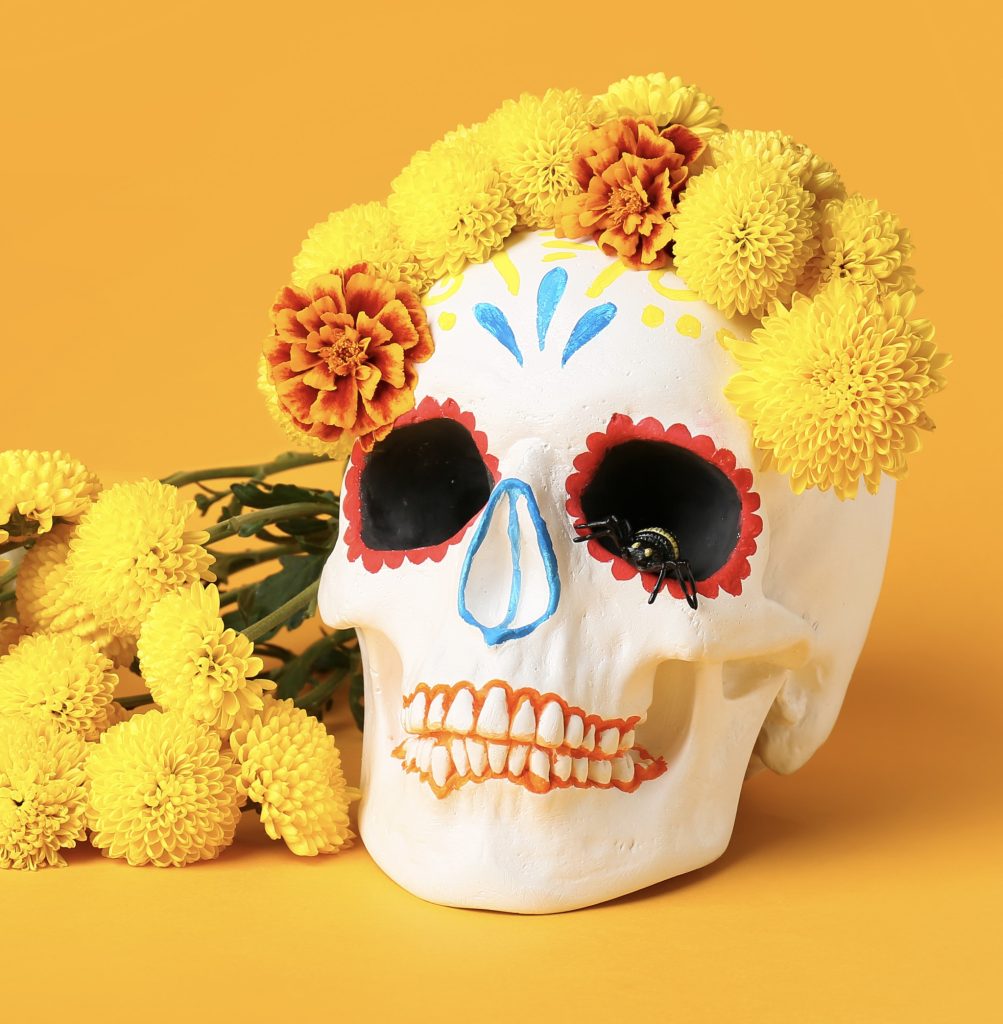
- Paintings and Sculptures: Artists draw from the marigold’s symbolism to craft vibrant paintings and sculptures that capture the spirit of the holiday. These artistic works pay homage to the traditions and elevate marigolds as iconic symbols of life, death, and remembrance.
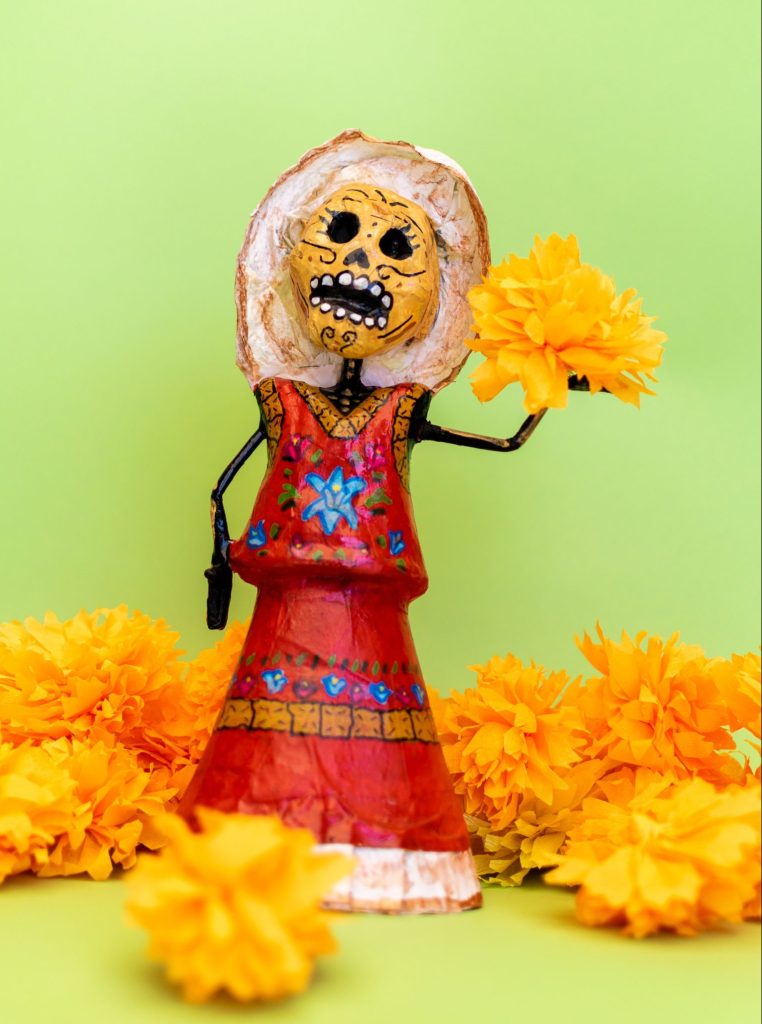
- Craft Projects: Many families, like mine, enjoy making Day of the Dead crafts incorporating marigolds. These projects encompass a range of creative activities, from making colorful paper marigolds to designing to pumpkin candle holders with marigolds that enhance the beauty of altars and ofrendas.
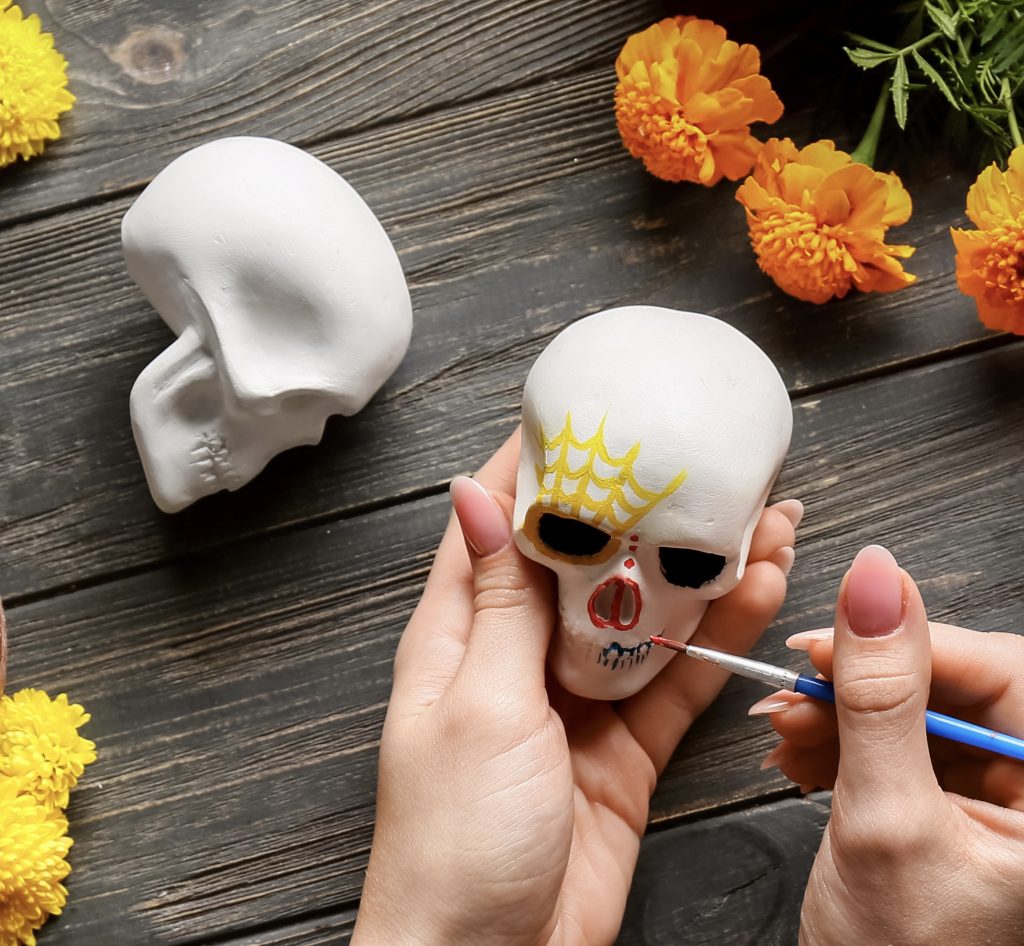
- Paper Marigold Flowers: Crafters fashion intricate paper marigold flowers that mirror the natural blooms. These paper creations are often used to decorate altars and ofrendas, bringing the essence of marigolds into the artistic realm.
- Papel Picado Banners: Marigolds are prominently featured in Papel Picado banners, which are delicate tissue paper banners displaying festive motifs. Including marigold designs in these banners enriches the visual tapestry of Día De Los Muertos decorations and celebrates the flower’s profound symbolic role in this cherished Mexican tradition.
Marigolds, with their radiant colors and deep symbolism, serve as wellsprings of creativity for Día De Los Muertos art and crafts. They infuse these artistic endeavors with vibrancy and meaning, adding to the richness of this beloved Mexican celebration.
You can also learn about other Day of the Dead flowers here. This article includes the most popular Día De Los Muertos flowers used to decorate ofrendas and graves during and what each flower symbolizes!
